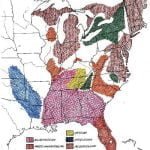
The groups of tribes continued to move, and by the beginning of the sixteenth century they were located approximately as indicated on tile last map.
The Iroquoian tribes had moved far eastward, and some occupied the country south of the St. Lawrence. The Hurons had settled north of Niagara, and the Eries remained south of the lake that bears their name. The Cherokee had become established far south in the Alleghenies, with Uchean tribes to the west of them.
The Siouan peoples had scattered far from their ancient homes in the valley of the Ohio Some had traversed the mountainous sections of Virginia and Carolina and reached the Coast; others moving more slowly, and undoubtedly reluctant to abandon the rich hunting grounds west of the Wabash, had probably arrived on the banks of the Mississippi and the shores of Lake Michigan. The Algonquian tribes had likewise moved farther away from their earlier habitat and some had already pushed southward on the Atlantic coast.
Muskhogean tribes occupied the greater part of the southeastern United States, and some of their villages, already old when visited by the Spanish invaders in 1540, -nay have been the sites of much earlier proto-Muskhogean settlements. The villages of the Calusa and Timucua tribes dominated the peninsula of Florida.
This was the distribution of the linguistic groups at the beginning of the historic era, when Europeans were soon to enter and traverse the vast, unknown region that lay between the Atlantic coast and the Mississippi.
